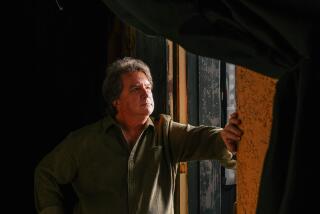Theater Review: Ethical quandaries buzz in ‘The Nether’
In the musical “Avenue Q,” there’s a happy-go-lucky song about a dirty little computer secret. It’s called “The Internet Is for Porn.”
Theatergoers from the respectable middle class giggle helplessly throughout this number, but imagine how quickly the laughter would cease if government agents knocked on their door demanding to review their Internet browsing history.
Such a scenario is underway in “The Nether,” the daring new drama by Jennifer Haley that opened at the Kirk Douglas Theatre Sunday. It’s a play that will no doubt be of great interest to those who spend a good chunk of their lives inside the cyber rabbit hole, interacting through avatars and screen names that may (I know this might be hard to believe) mask their actual identities.
But “The Nether,” which deals with sexual subject matter that should have everyone squirming in their seats, isn’t just for Web junkies. Haley has written a truly 21st century play about virtual reality and responsibility. The drama (winner of the 2012 Susan Smith Blackburn Prize) articulates its themes a bit too explicitly in places, but that is perhaps a necessary safety for a work that dramatizes onstage the furtive fantasies that damaged adults confide to their laptops.
Set in what appears to be the dystopian future, the play begins with the Kafkaesque interrogation of a businessman named Sims (Robert Joy) who pretends not to know why he’s being detained. But the line of questioning — about how many hours he spends “in the nether” (the new name for the Internet) and the location of his server — is making him exceedingly jumpy.
Later, Morris (Jeanne Syquia), the detective running the investigation, grills Doyle (Dakin Matthews), a middle school science teacher nearing retirement, about his experiences in the virtual world called the Hideaway. This is the zone that Sims has created for men who are attracted to underage girls and is characterized by Morris as “the most advanced realm … when it comes to the art of sensation.”
The Hideaway invites those with pedophilic proclivities to don a high-tech headset and a pair of special glasses and mentally check in to a Victorian-era inn, in which Papa (Sims’ virtual identity) plays the rule-enforcing host and Iris (Brighid Fleming), a flirtatious little darling, coaxes the customers to act out their outlawed desires.
To prevent anyone from getting too emotionally attached, Iris has been advised by Papa to offer the gentlemen an ax so they can butcher her after they’re through. (No one ever dies in this sub rosa nook of the nether, though the blood is frightfully convincing.)
The production, directed by Neel Keller, makes ingenious use of Adrian W. Jones’ revolving two-tier set. When the play first moves from the stark interrogation room to the perverse faux 19th century playpen, the astonishment in the audience is audible. Not only have the fantasies of the characters become unexpectedly real but the author’s imagination has completely surprised us.
PHOTOS: Arts and culture in pictures by The Times
It also has us on edge. Sims defends the Hideaway by reminding Morris that it’s an adults-only realm. (Behind Iris’ avatar is a grown-up who has undergone an extensive background check.) But the actress playing Iris onstage is still a minor at 13.
How is the production going to even suggest the sexually explicit conduct that takes place between Iris and Woodnut (Adam Haas Hunter), the mysterious young man who pays a visit to the Hideaway? One wrong move and the Douglas could get closed down by Child Protective Services.
All credit to Keller for navigating his cast through these perilous scenes. He is aided immeasurably by the preternatural maturity of Fleming, who looks like she’s in junior high but has the professionalism of an established pro. Usually whenever the virtuosic Matthews is onstage, everyone else in the company winds up playing second fiddle. He’s superb as usual, but Fleming is the one who commands our attention, adopting the outward facade of an adolescent while subtly projecting the consciousness of a person decades older.
Hunter is captivating as the reluctant Woodnut, whose role in the intrigue (although increasingly obvious) needs to be kept under wraps. Joy is at his best in his scenes as Papa, issuing instructions to Iris with a creepy paternal affection that is psychologically on the money.
But something isn’t clicking theatrically in the interaction between Sims and Morris. This is partly the result of the playwright spelling out the conflict between these two characters a bit too academically. Sims believes that by allowing individuals to indulge their fantasies in the virtual world, they are less likely to act them out in the real one. Morris, on the other hand, argues that “images — ideas — create reality. Everything around us … began as figments in someone’s mind before becoming a physical or social fact.”
This collision of ideas is important for many reasons, not least for the way it allows us to understand how these questions of identity, sexuality and imagination predate the Internet. But the writing’s occasional awkwardness can throw the actors off course. (Syquia’s unsteady performance suffers the worst.)
Yet “The Nether” is an impressive new work that should be seen by theatergoers eager to make the acquaintance of a Los Angeles-based playwright who is as boldly inventive as she is ethically conscious. And for all those hipsters in Venice, Culver City, Los Feliz and Highland Park who don’t believe the theater has anything to say to them: Haley knows your user name.
-----------------------------------
‘The Nether’
Where: Kirk Douglas Theatre, 9820 Washington Blvd., Culver City
When: 8 p.m. Tuesdays-Fridays, 2 and 8 p.m. Saturdays, 1 and 6:30 p.m. Sundays. (Call for exceptions.) Ends April 14.
Price: $20-$50
Contact: (213) 628-2772 or https://www.centertheatregroup.org/thenether
Running time: 1 hour, 30 minutes
MORE
INTERACTIVE: Christopher Hawthorne’s On the Boulevards
Depictions of violence in theater and more
PHOTOS: Arts and culture in pictures
More to Read
The biggest entertainment stories
Get our big stories about Hollywood, film, television, music, arts, culture and more right in your inbox as soon as they publish.
You may occasionally receive promotional content from the Los Angeles Times.







